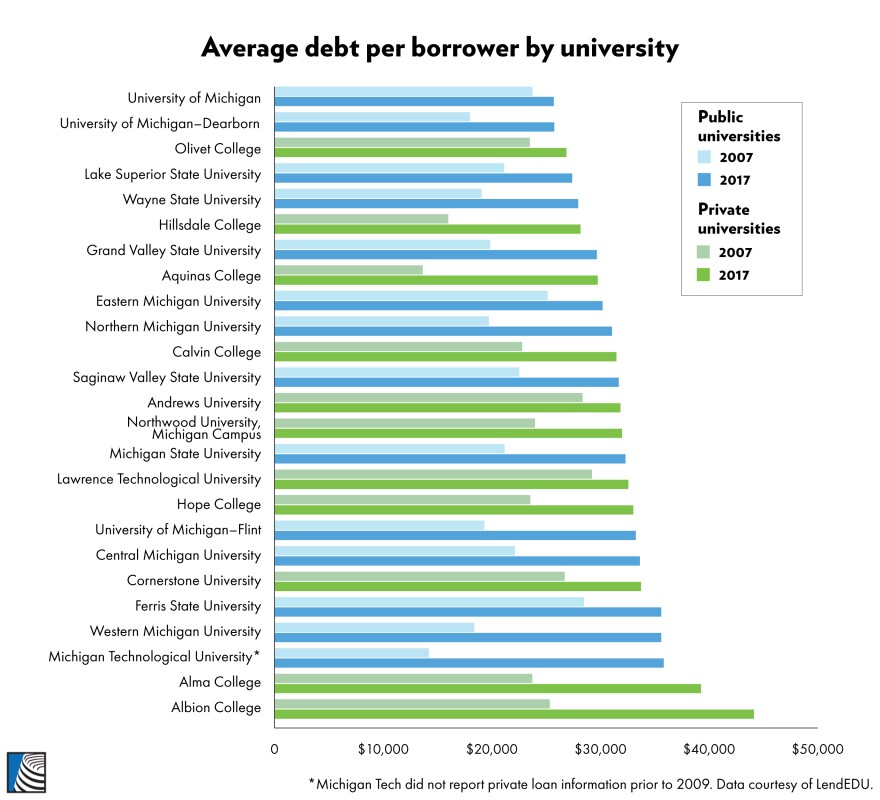Michigan college grads are borrowing 42% more on average than they were 10 years ago. Today, your average Michigan student with school loans has about $31,000 in debt, compared to roughly $21,600 a decade earlier.
That's probably not a shock to anybody. But the picture looks wildly different depending on the school you choose - and now, we've got a glimpse at how Michigan colleges and universities compare over the last 10 years.
That's because LendEDU, an online marketplace that ranks financial services (think credit cards and loan refinancing) recently pulled the data from nearly 1,000 colleges nationwide. That data comes from what schools submitted to Peterson’s financial aid database (for-profit schools and certain vocational or cooperative colleges aren’t included.) Then the researchers compared the most recent available data (from 2017) to the numbers ten years prior (2007.)
Let’s start with the big picture: the percentage of all students graduating with debt at each school.

Private schools like Olivet College, Cornerstone University and Alma College take the top three spots here (and we’re gonna talk about why in the next section) but those rates were still pretty high 10 years ago. So when you look at where rates are changing the most drastically, you see public universities in Michigan are experiencing the biggest increase in percentage of grads with debt.
For example: the University of Michigan-Flint saw the biggest jump in the percentage of students graduating with debt: from 24% of grads in 2007, up to 58% in 2017. Student borrowers there are now averaging about $33,000 in debt.
The other biggest jumps were also at public schools: Wayne State University and Saginaw Valley State University, which both saw a 13% increase in students with debt, and Northern Michigan University with a 12% increase.
That same overall trend is mirrored in the national numbers, too, with public universities seeing a nearly 5% jump in graduates with debt. Meanwhile, private schools nationwide actually had a 1% decrease.
One of the driving factors here is the rise of the nontraditional student, says Kristin Seefeldt, author of Credit Where It's Due: Rethinking Financial Ciztenship and professor at the University of Michigan School of Social Work.
“We are seeing more students who have had this label of 'nontraditional student,' which I think is sort of a misnomer,” she says, given that they’re now the majority of students enrolling in college classes.
“Nontraditional” is a catch-all term for students typically over age 24, who are more likely to be on their own in terms of paying for school. They’re also more likely to have kids, be balancing full-time jobs, and may not have a traditional high school diploma.
"Now you have students who, 25 years ago, might not have had the opportunity to go to college - so, students whose families don’t have as many financial resources,” Seefeldt says. “So while they may be qualifying for financial aid, financial aid has not kept pace with rising college costs. So you have students who have more need, but the types of grants and aid we can give them is just not there.”
Nontraditional students make up a big part of enrollment at the University of Michigan-Flint, according to Lori Vedder, the University of Director of the Office of Financial Aid.
"We have a nontraditional campus profile and many of our students do attend part-time,” she says via email. “That means our four-year graduation rates are lower than our six-year rate. This can mean students take on an additional two years of debt.”
A lot of those students are coming to school because they’ve hit hard financial times, and have to balance limited resources between family and college costs.
“...[I]t is possible they may use [a portion of] their loans to help fill the gap of lost wages or a reduction in pay,” Vedder says.“One other thing that may have contributed is that during that time span, UM-Flint opened residence halls so students could live on campus. Many opted to borrow in order to meet those costs.”

Private schools take the top spots for average debt load
Small private schools like Albion College and Alma College saw big jumps in the size of the average debt load over the last 10 years. At Albion College, it rose 118%, from about $25,000 ten years ago to closer to $44,000 now - the highest in the state. The biggest driver here is a nearly $20k increase in sticker price, says Rob Kniss, director of student financial services at Albion.
“Overall costs of college go up every year, this is by no means unique to Albion,” he says. “You want to build up a good university with a good reputation, make it attractive for students to want to come there, so you have to hire good faculty and staff. And to hire good faculty and staff, you need to make their salaries competitive.”
It’s relatively affluent families who are taking on most of that debt at Albion, Kniss says, because the school earmarks most of its financial aid for lower-income students.
“Albion’s demographics have changed as a whole, and so too have the demographics of our students taking out loans,” he says. “In 2012, about 13% of our students received Pell Grants," and now it's closer to 39%.
Meanwhile, at Alma College, the average student borrower has about $39,000 in loans. That’s almost a $15,000 increase from ten years ago. And because the cost of school is going up, students have to take on larger loans, says Michael Silverthorn, a spokesperson for Alma College.
"College costs that have risen more swiftly than family income,” he says. “Many families rely on private borrowing to fund their children’s education. Alma, like most colleges and universities, has increased the amount of financial aid we award to our incoming students. Every incoming student at Alma is awarded an institutional grant or scholarship; in 2018-19 our average freshman award was $28,400.”
Public schools say state cuts mean more debt for students, families

Among the state’s public schools, Michigan Technological University has the highest average debt per borrower today, coming in at more than $35,000. But the school’s graduates also boast one of the highest average salaries (ten years out of school) in the state.
“We also have one of the lowest loan default rates in the state of Michigan,” says Joe Cooper, Michigan Tech’s director of student financial services, “with the most recent draft rate reported at 2.8%.”
Meanwhile, state schools like Western Michigan University (which had a 93% increase in average debt per borrower) and University of Michigan-Flint (72% increase) also saw a significant jump in the average debt load their student borrowers are taking on. Beyond the rise in nontraditional students, another big reason here is state aid cuts, public school advocates say.
“The primary reason...in this state for the increase in student loan debt has been what I call the state-to-student cost shift in who’s paying for a public university education,” says Dan Hurley, CEO of the Michigan Association of State Universities.
While there’s been a “modest increase” in state money for public colleges since 2013, Hurley says the longer term trend isn’t good: in 2019, public universities in Michigan got $165.5 million less from the state than they did in 2011, adjusted for inflation.
The picture also gets more nuanced once you drill down on those numbers: yes, WMU saw a big increase in average debt loads for borrowers, but that’s partly because the school’s average debt was really small ten years ago compared to other schools. Back in 2007, student borrowers at WMU were taking out an average of just $18,400; that’s less than just about every other public university at the time. Today, WMU borrowers are graduating with an average $35,602 in loans, which puts them on par with grads from Ferris State and Central Michigan University.
*Quick note about Michigan Tech: the original data reported to Peterson’s, and used by LendEDU, makes it look like the Upper Peninsula school saw a staggering 151% increase in the average amount of debt per student borrower. But those numbers don’t show the full picture, says Joe Cooper, Michigan Tech’s director of student financial services. That’s because 10 years ago, Michigan Tech wasn’t reporting private loans.
“For whatever reason, before the 2009-2010 year, Michigan Tech was not reporting private loan information in this data,” Cooper says. “ Once we realized this error at the time, we… [included] private loans moving forward after 2009… These discrepancies in reporting were before my time at the institution, so I can't speak to the specifics, but what I can say is that the 151% average debt increase being reported by LendEDU is not accurate for Michigan Tech.”
We’ve adjusted our graphs to reflect what Michigan Tech says is the full financial picture.
If you add in the private loans Michigan Tech should have reported in 2007, then the school’s average debt per borrower jumps by just 36%, Cooper says. Over the last five years, it’s seen just a 1% increase.
This post was updated on Friday, July 19








